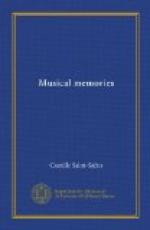Hans de Buelow once said to me in the course of a conversation,
“After all Meyerbeer was a man of genius.”
If we fail to recognize Meyerbeer’s genius, we are not only unjust but also ungrateful. In every sense, in his conception of opera, in his treatment of orchestration, in his handling of choruses, even in stage setting, he gave us new principles by which our modern works have profited to a large extent.
Theophile Gautier was no musician, but he had a fine taste in music and he judged Meyerbeer as follows:
“In addition to eminent musical talents, Meyerbeer had a highly developed instinct for the stage. He goes to the heart of a situation, follows closely the meanings of the words, and observes both the historical and local color of his subject.... Few composers have understood opera so well.”
* * * * *
The success of the Italian school appeared to have utterly ruined this understanding and care for local and historical color. Rossini in the last act of Otello and in Guillaume Tell began its renaissance with a boldness for which he deserves credit, but it was left to Meyerbeer to restore it to its former glory.
It is impossible to deny his individuality. The amalgamation of his Germanic tendencies with his Italian education and his French preferences formed an ore of new brilliancy and new depth of tone. His style resembled none other. Fetis, his great admirer and friend and the famous director of the Conservatoire at Brussels, insisted, and with reason, on this distinction. His style was characterized by the importance of the rhythmic element. His ballet music owes much of its excellence to the picturesque variety of the rhythms.
Instead of the long involved overture he gave us the short distinctive prelude which has been so successful. The preludes of Robert and Les Huguenots were followed by the preludes of Lohengrin, Faust, Tristan, Romeo, La Traviata, Aida, and many others which are less famous. Verdi in his last two works and Richard Strauss in Salome went even farther and suppressed the prelude—a none too agreeable surprise. It is like a dinner without soup.
Meyerbeer gave us a foretaste of the famous leit-motif. We find it in Robert in the theme of the ballad, which the orchestra plays again while Bertram goes towards the back of the stage. This should indicate to the listener his satanic character. We find it in the Luther chant in Les Huguenots and also in the dream of Le Prophete during Jean’s recitative. Here the orchestra with its modulated tone predicts the future splendor of the cathedral scene, while a lute plays low notes, embellished by a delicate weaving in of the violins, and produces a remarkable and unprecedented effect. He introduced on the stage the ensembles of wind instruments (I




